Step away from the box – boxed chicken broth, that is, and learn to make homemade chicken broth. Its hands down, the best. Simmer meaty chicken pieces and bones for 12-20 hours with carrot, onion, celery and herbs, then strain, cool and freeze. The house will smell heavenly and you will have golden broth in the freezer to use for fantastic soups, stews, risottos and just sipping.
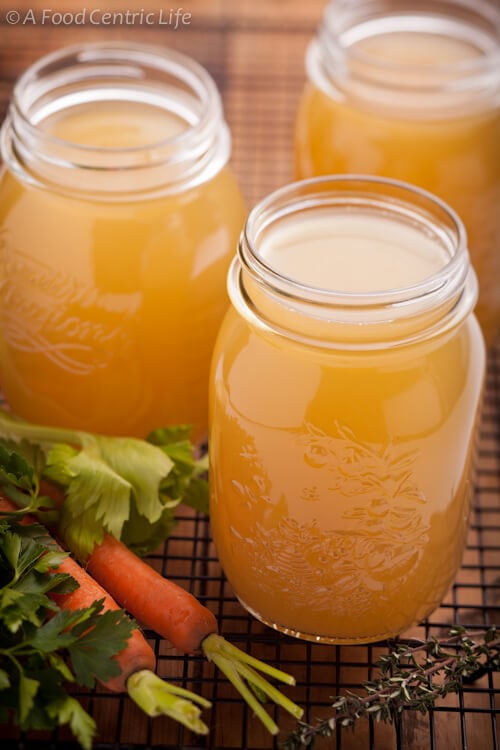
Making homemade chicken broth is easy. Most of the time is hands off while it simmers on the stove.
Jump to:
Chicken Broth or Stock?
Is it broth or stock? These days the terms are used interchangeably. Traditionally, chicken broth is made with meaty chicken pieces and vegetables and chicken stock is made from just bones and sometimes vegetables. I use a combination for the best flavor and nutrition.
What Kind of Chicken?
When making homemade stock I use a whole, cut-up organic chicken or bone-in chicken thighs and leg pieces. Adding chicken feet provide extra collagen and great body and nutrition to the broth. Check with your butcher and ask if they have chicken bones or parts for sale. It will usually be backs and necks from chickens they cut up. They all work, as long as there are bones. While chicken feet are creepy your broth will be like jello.
Chef's Note: Why go to all of this work? The biggest reason to make bone broth at home is taste and control of ingredients. Some taste weak flavored while some off strange off-flavors. Store broths are usually filled with sodium for taste and as a preservative, while homemade has zero. If you read the labels on most store brands, you will be shocked at not only the sodium content but other ingredients (like sugar). Not healthy. Homemade tastes so much better than anything store bought.
One more note on bones - After I roast whole chickens, I strip of most of the meat for other uses like soups, stews, chili, enchiladas, salads or tacos, but save the bodies and freeze them. When I get about 5 frozen bodies (plus I add chicken feet), I make broth. Great way to really use the whole chicken and not waste anything. The broth is not as clear, but it tastes great and is thrifty.
Prepare the Chicken
To prepare your chicken, rinse and remove as much skin and any extra fat as possible. That means less skimming and fat at the end. If using a whole chicken, you’ll need to cut it up into pieces. Follow the photos. Use a sharp French or chef’s knife or a cleaver.
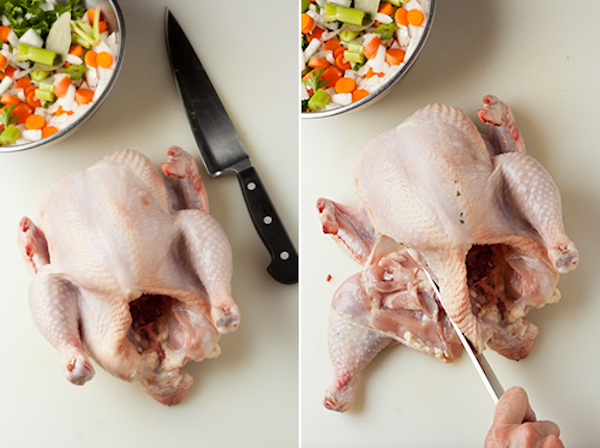
How to Cut a Whole Chicken
Start by freeing the leg-thigh major piece above the joint. Cut through the skin and cut above the joint. Bend the chicken in your hands to tell where it is. The joint will pop out. Remove the skin then cut this larger piece into the leg and thigh. Next, cut off the wings, again above the joint. Next, cut off the breasts. Start by slicing through the center breast bone. Free the breasts from the body and cut them in half crosswise.
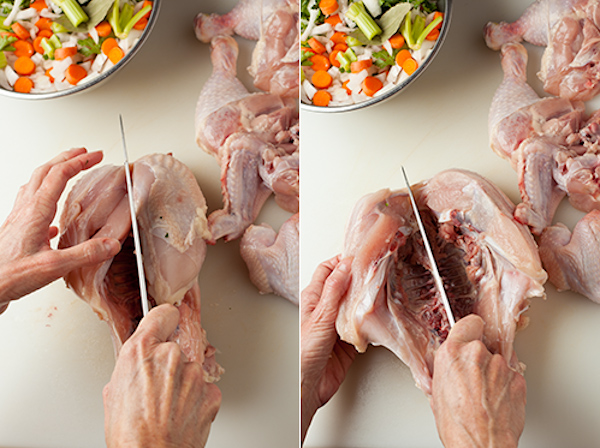
Lastly, cut what is left of the body in half crosswise. You will end up with twelve pieces. After cutting up raw poultry, immediately wash and sanitize your tools.

What is That Scum?
The brownish, foamy scum that appears when you first begin to simmer your broth is impurities being released. Skim if off and discard every few minutes until it’s gone. Skim, skim, for a good clear broth.
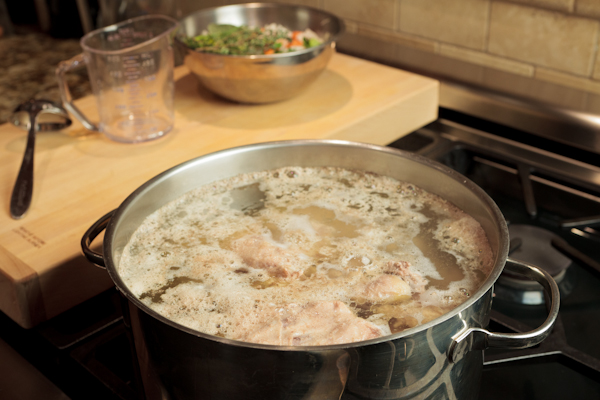
Add Aromatics and Skip the Salt
Next, add your aromatics and herbs. I add carrots, onion, celery (all organic), a dried bay leaf or two, black peppercorns, fresh parsley and thyme sprigs. What don’t I add? Salt. Skipping salt allows you to add the right amount of salt in your final dish to meet your tastes.
A no sodium broth is also good for people with sodium restrictions. And be sure to add 1-2 tablespoons of apple cider vinegar. It helps the pull the nutrients from the bones. Bragg raw apple cider vinegar is a good choice as its unfiltered and unpasteurized.
Add Boiling Water as Needed
As your broth simmers over a few hours, the water level will drop. I keep an electric tea kettle of hot water going and add water as needed. Don't worry, it won't dilute the broth.
Keep it at a Simmer
Never cook your broth above a low simmer. If you boil or stir it your broth will be cloudy. Just let it happily bubble away, filling your house with heady fragrance.
On Bones and Bone Broth
Articles about the healing benefits of bone broth are everywhere. Bones are important because they contain collagen protein. That’s what gives the broth body, flavor, richness and health-giving properties.
When you simmer your broth for long periods, the collagen and minerals break down and release into the broth. When cooled, good broth will be wiggly like gelatin. That’s because of the collagen.
I simmer my broth for 20+ hours to extract as much collagen and nutritious minerals from the bones as possible.
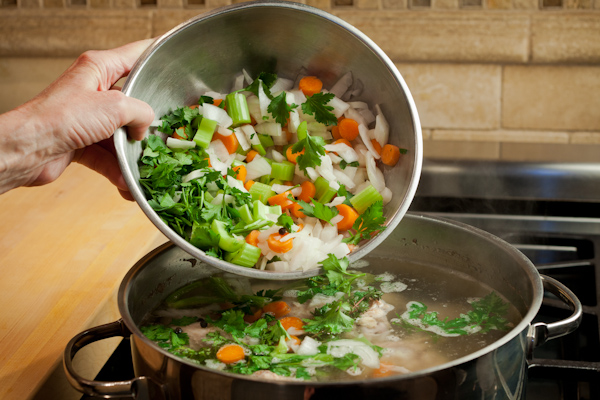
Finishing the Broth: Cooling
At the end of simmering, your homemade chicken broth will be deep golden and clear. Carefully strain out the spent bones, meat, vegetables and herbs. Discard them, as they have given their best to your broth.
Place the strained broth in a large stainless steel bowl or another pot and place it in a sink of ice water. This will help it cool quickly. To speed the cooling, place a trivet under the bowl or pot for ice water circulation. Stir occasionally until it’s cool.
From there, refrigerate overnight (covered) and skim the solidified fat off the top in the morning. Use your chicken broth within three days or freeze in portions. Freeze in muffin tins for small measures, canning jars, mason jars, and larger containers.
Measure it out, label (masking tape or kitchen labels and a Sharpie should always be in the kitchen) and freeze for up to three months. I freeze in 3 cup, 1 cup and ½ cup portions.
A Note for Histamine Intolerance
Because of the long simmer time of the bone broth, it may cause flare ups for people with HIT or MCAS. After you are healed and managing, you might be able to enjoy this. I do and I have both HIT and MCAS. For a 2-hour, low histamine chicken broth made in the Instant Pot try this recipe.
📖 Recipe

Homemade Chicken Broth (Bone Broth)
Equipment
- 12 quart stockpot
Ingredients
- 1 5 pound whole chicken or 5 pounds thighs, legs, backs, wings, feet and bones
- 1 pound chicken feet or 1 more pound chicken pieces (optional)
- 2 large celery ribs roughly chopped
- 2 medium carrots scrubbed, roughly chopped
- 1 medium onion roughly chopped
- 1 large dried bay leaf
- 1 handful parsley leaves and stems
- ½ teaspoon black peppercorns
- 6 sprigs fresh thyme
- 1-2 tablespoons apple cider vinegar
- 4 quarts filtered water
- Extra boiling water as needed
Instructions
How to Cut up a Whole Chicken
- If using a whole chicken, break it down into pieces with a sharp French knife, Chef’s knife, or cleaver. See the photos in the post for help. Start by cutting off the leg and thigh pieces and cut them in half at the joint, then cut off the wings. Next, cut through the center breast bone of the chicken, splitting the body into two halves. Cut the breasts free and cut them in half. What’s left is the body. Cut that in half crosswise. Remove excess skin. Poultry shears also help break it down.
Start the Broth
- Add the chicken pieces to a large stock pot, about 10-12 quarts. Cover with the water and bring to a simmer. As the chicken simmers, impurities will begin to rise to the top. It looks like a gray foamy scum. Skim it off and discard. Continue to skim and discard until its mostly gone.
Long Simmer the Broth
- Add the vegetables, peppercorns, thyme and apple cider vinegar. Keep the pot at a low simmer for 20-24 hours, adding boiling water from a kettle if the water level gets low. The longer you simmer, the better.
Strain and Chill the Broth
- Strain out the spent vegetables, meat, bones, etc. and cool the broth in a large stainless steel bowl or pot in a sink filled with ice and water. Place a small rack or trivet under the pot to speed cooling. Stir occasionally to assist cooling. Refrigerate broth, covered, overnight.
Use and Freezing
- Skim off the solidified fat in the morning. Use broth within 3 days or portion and freeze in small containers, labeled, for up to three months.
Cathy Rowe says
I made this last week...used 8 pounds of whole chicken thighs.
It has no flavor!!!
Added all the stuff on the list plus upped the amount. Cooked for 24+ hours...
Looks great taste like nothing!!!
What did I do wrong!!??
Sally Cameron says
Hi Cathy. That is really odd. I've been making this for many, many years and it tastes terrific every time. One thing, you don't need to cook it that long. I usually do mine for about 20. But I am not sure that is why it doesn't have flavor. I don't see how it couldn't with all of the great ingredients and a long low, slow simmer. I always use organic, but I'm again not sure that would effect the taste that much. How did you taste it? If you sipped it as broth, did you add a little salt? It has no salt so you can add how much you want for how you are using it. Have you used it in a recipe yet? And just to confirm, you used bone-in thighs, right?
Melissa S. says
Would a pressure cooker (like an Instapot) work for making the broth? Would it affect the nutrition of it?
Thanks.
Sally Cameron says
Hi Melissa. Good question, the Instapot is popular these days, and I now have an Instant Pot chicken broth recipe that is terrific. It's what I make most of the time now for the speed, and it tastes terrific and is nutritious. https://afoodcentriclife.com/instant-pot-chicken-broth.
Nadine says
I'm wondering- Is this something I can pressure can for storage?
Sally Cameron says
Hi Nadine. I always freeze mine and have never tried pressure canning it. Here is a link I found with good directions. Maybe this will help. There are also other articles on the internet for canning. Good luck! http://www.culinate.com/mix/dinner_guest/how_to_pressure_can_stock
Tammy says
I am very new to all of this. My husband has a Traumatic Brain Injury so I am finding myself looking to save money, getting the best flavor , and spending my down time.
What do I do with the skin and insides as to not to waste?
Sally Cameron says
Hi Tammy. First, I am so sorry to hear about your husband and TBI. May God bless you both and heal him, and give you strength as his caregiver. Cooking is a great way to save money, and get healthier, more nutritious food on the table. The skin and insides (giblets) are fine to discard. You are not wasting much. Some people use part of the giblets, say, from a turkey, as part of a turkey dressing, but not usually from a chicken in my experience. There is nothing you can do with the skin. One thrifty idea, If you first roast a whole chicken, eat all of the meat over a few days (or freeze it), then save the carcass with a little meat attached, you can freeze it. Then when you have a few carcasses, make broth. It's really making use of something many people discard. You get full use of that chicken. Hope this makes sense. If not, please comment again and lets keep talking.
Lauren says
I've seen many different ideas for freezing it, which is my best option. If you freeze it in one ounce cubes and then transfer to a plastic bag, do you run the risk of ice crystals developing all over it? I would love to know a great recommendation for freezing it in both large and small portions. Also, if you freeze it, can you thaw in fridge and it will still keep for a few days??
Sally Cameron says
Hi Lauren. Ice cube trays works fine. I did that in the past but they are really too small for me. Most of the time I am using more, like 1-3 cups. I used to freeze broth in muffin pans that were about 4 ounces, so 1/4 cup. After frozen, pop them out and place them in a freezer zip bag. For larger portions, like 1-3 cups, I am using the Glasslock containers. Just started trying those. Used to use BPA-free plastic, but know that glass is better. Many people freeze broth flat in plastic freezer zip bags, laying them flat on a small, quarter rimmed baking sheet. When frozen they stack flat. Only issue I have with that solution is that if you get a leak they get messy upon thawing, so just remember to thaw them in the refrigerate on a bowl, pot or something to catch any possible leakage. Good question! Hope that helps. Blessings, Sally
Kayla says
Hi there, do you keep tinge chicken after to eat it or what do you do with the chicken? I've never done this before so don't want to mess it up. Can I can this after it is done to have for soups and recipes that call for chicken broth? Thanks
Sally says
Hi Kayla. Thanks for your question. After the chicken has simmered to create the broth for so long, it's pretty much give up its all for the broth. It's not very good to eat at that point. I toss it. Let me know how you do. I have never tried canning my broth because I freeze it, which is easy. Homemade broth tastes fantastic compared to anything boxed or canned from the store, and is so much better for you. Hope that helps. If you need more help, please let me know.
Linda Chin says
Hi Sally, I used this method with a frozen turkey carcass leftover from Thanksgiving and the family said it was the best homemade soup I had ever made them.......I make homemade soup fairly often in the Winter. All your little tips really make a difference, thank you! Also I love the idea of trying this with my pasta pot insert. I have some frozen chicken bones that will be my next try.
Sally says
Sally, beautiful! Great instructions on how to break down a chicken and turn it into stock. I try to buy necks and backs (organic, when they have them) and supplement with legs with thighs attached--about 8 pounds in all. I look for bargains and freeze if I can't make the stock right away. I also save bits and pieces in the freezer when I bone a chicken or remove chicken backs or wings. Lately I've been trying out making stock in the insert in my pasta pot. I'm not sure yet what I think, but it IS much easier to pull out the messy bits before straining. I strain right away into quart containers--it cools faster in smaller containers. Then I let it cool briefly and refrigerate overnight. The next day I spoon off the fat (once it's hardened) and pop that liquid gold in the freezer. I urge everyone to actually taste the stuff that comes in the box--I've done tastings in cooking classes. The word "dishwater" came up often (!) I like your muffin cup idea, too!
sally says
Hi Madonna. Glad it was helpful! I don't bother making beef stock as I don't use it often. When I do, I buy a good quality frozen brand.
Madonna says
This is beautiful. Even though I have made a lot of stock I always learn something from your tutorials. I always added the veg immediately, but now see the benefit of waiting to skim first. Also, good idea to freeze some in muffin tins for that recipe than calls for just a little stock. I love the thought of having stock ready to make soup or risotto. Any chance you will be making beef stock? When I make short ribs or beef bourguignon the recipes always call for beef broth/stock and all the ones in the market contain soy. As usual your photos are just wonderful.
Sally says
Hi Madonna. Glad it was helpful! I don't bother making beef stock as I don't use it often. When I do, I buy a good quality frozen brand that seems to be a better options than cans or boxes. So glad you still learned something as i know you are a good cook!
Kathy Gold says
Great post and photos, Sally. The 2nd Wednesday of every month is stock making day at In The Kitchen, and we make enough for the month. We leave it overnight in our AGA and I strain, cool and package it all the following day. Quite a process, but so worth the effort.